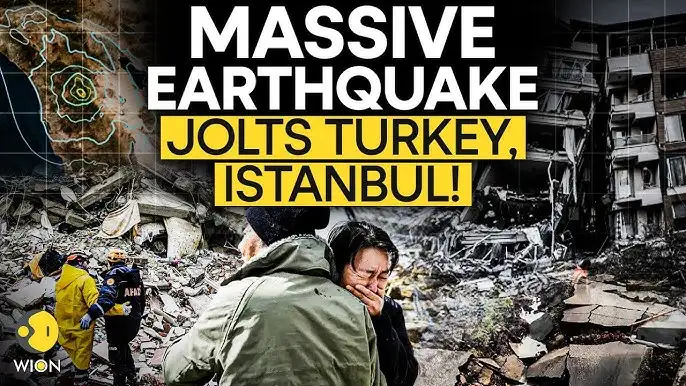Earthquake of 6.2 Magnitude Jolts Istanbul, Turkey
On a seemingly ordinary day, Istanbul, one of Turkey’s most populous and vibrant cities, experienced a powerful earthquake with a magnitude of 6.2. The tremors, which spread across the city and surrounding areas, left many residents and authorities worried about both the safety of the city’s infrastructure and its people.

The Event
The earthquake struck early in the morning, catching many people off guard as they went about their routines. It originated around 10 kilometers below the earth’s surface, a shallow depth that often results in stronger shaking at the surface. The epicenter lay in the Sea of Marmara, just off Istanbul’s coast—a region known for its seismic activity.
Although strong, the earthquake did not cause widespread destruction like some of the more significant quakes in the region’s history. However, it still caused notable damage and sparked fear among the residents. Istanbul, with over 15 million people, sits near major fault lines, including the North Anatolian Fault, which puts the city at a high risk of earthquakes.
Immediate Impact
As the earthquake hit, buildings swayed, windows shattered, and sirens rang out across Istanbul. Panic spread in some neighborhoods, as people rushed into the streets seeking safety. Many residents feared a repeat of past earthquakes, which had caused major damage in the city.
Initial reports indicated that some buildings and infrastructure had sustained damage. Older structures appeared the worst hit, with visible cracks in walls and roads. In some areas, falling debris injured several people. Emergency response teams quickly sprang into action, and rescue operations began immediately.
Authorities maintained high alert, opening evacuation centers for displaced individuals and providing medical treatment to the injured. Although initial reports suggested that people had become trapped under rubble, the exact number of casualties was still unclear. Despite the chaos, Istanbul’s emergency services worked quickly to mitigate further risks.
Seismic Activity in Istanbul
Istanbul faces an ongoing risk from earthquakes due to its location near the North Anatolian Fault, a major fault line running through northern Turkey. The city has experienced several significant tremors in the past, and experts have long warned of the possibility of a large-scale earthquake.
While this recent tremor was intense, experts expected it. They have long predicted that the region will face another significant earthquake, and some estimates suggest that the city could experience a devastating quake within the next few decades. In response, the Turkish government and local authorities have taken steps to strengthen buildings, improve infrastructure, and conduct earthquake drills for residents.
This recent earthquake serves as a reminder of Istanbul’s seismic vulnerability. It also highlights the importance of continued preparedness efforts and public awareness campaigns. Despite the damage caused, it’s evident that the city’s response system and residents’ awareness played a key role in minimizing the quake’s impact.
Ongoing Efforts
Hours after the earthquake, Turkish President Recep Tayyip Erdoğan reassured the nation, promising that the government would do everything possible to assist those affected. The Turkish Disaster and Emergency Management Authority (AFAD) was activated, deploying rescue teams to the affected areas.
Local hospitals reported receiving a surge of patients, mostly those with minor injuries from falling debris or accidents caused by panic. Medical teams worked tirelessly to treat the injured, and the Ministry of Health sent additional personnel and supplies to assist with the recovery process.
Authorities inspected public buildings, schools, and hospitals to ensure that they remained structurally safe. Meanwhile, engineers began evaluating damage to essential infrastructure, including bridges, roads, and power lines. The recovery process continued, and it became clear that the situation was under control.
The Role of Technology and Preparedness
Technology played a significant role in managing the aftermath of the earthquake. Early-warning systems, which have improved in recent years, helped alert residents in certain areas, giving them a brief window of time to find cover before the shaking began. Real-time data from seismic monitoring stations enabled authorities to assess the situation quickly and deploy the necessary resources.
Turkey has invested in earthquake-resistant technology for its buildings, especially in Istanbul. These efforts have helped reduce casualties and damage. While the tremors were strong, many modern buildings withstood the shaking, demonstrating the effectiveness of the country’s seismic preparedness.
Moving Forward: What’s Next for Istanbul?
As Istanbul begins the recovery process, it must focus on improving its preparedness for future seismic events. This earthquake underscored the need to strengthen the city’s infrastructure, especially older buildings that might not meet modern seismic standards. Authorities also need to prioritize public education about earthquake safety.
The government and local authorities are likely to increase funding for earthquake preparedness programs, including retrofitting vulnerable buildings and investing further in early-warning systems. Experts encourage residents to take responsibility for their own safety by learning earthquake safety protocols and assembling emergency kits.
Although the 6.2 magnitude earthquake caused disruption and damage, the swift response and ongoing recovery efforts have been commendable. Istanbul, a city rich in history and culture, will undoubtedly continue to adapt and improve its readiness for future challenges. The city’s resilience in the face of natural disasters will be tested again, but with the right preparations, Istanbul can emerge even stronger.






